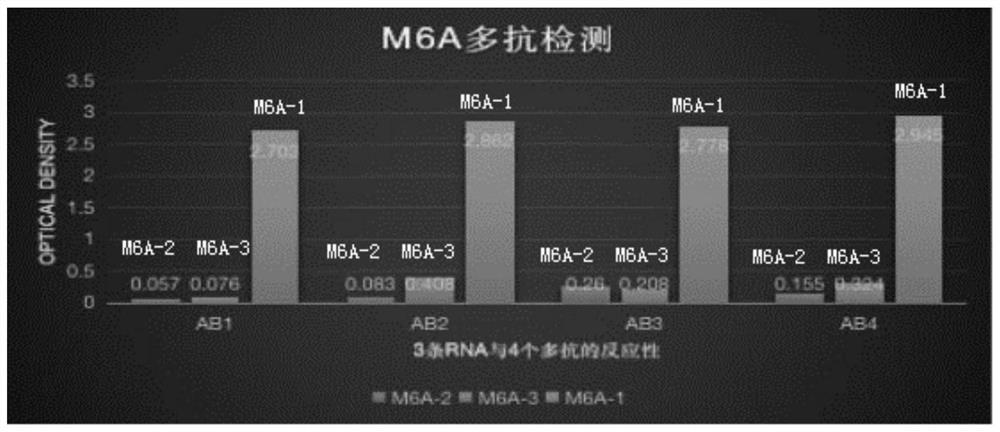M<6>A recombinant rabbit monoclonal antibody and preparation method thereof
A monoclonal antibody and heavy chain technology, applied in the field of molecular biology, can solve problems such as low sensitivity, difficult IF experiments, and difficult enrichment, and achieve the effects of improving screening efficiency, easy screening, and high gene diversity
- Summary
- Abstract
- Description
- Claims
- Application Information
AI Technical Summary
Problems solved by technology
Method used
Image
Examples
Embodiment 1
[0034] The present invention provides a kind of by m 6 A method for synthesizing an antigen from a hapten, the specific steps are as follows:
[0035] 1. Weigh m 6 A small molecule 40mg, add to a 50ml test tube, then add 0.1M NaIO drop by drop 4 Solution until 5ml, shake while adding, react at room temperature for 30 minutes. Add 1ml ethylene glycol to neutralize excess NaIO 4 , react at room temperature for 5 minutes.
[0036] 2. Take 10ml of KLH carrier protein (Merck, product number: 374805) with a concentration of 6.15mg / ml, add it to a new 50ml test tube, and use 2M K 2 CO 3 The pH value of the solution was adjusted to be between pH 9.0 and 9.5.
[0037] 3. Then slowly add the carrier protein in step 2 to the solution in step 1 and react for 45 minutes. 5% K during 2 CO 3 The pH of the solution was adjusted to maintain the pH between 9 and 9.5.
[0038] 4. Weigh 37.5mg NaBH 4 Dissolve in 2.5ml of water, add dropwise to the reaction solution in step 3, shake whi...
Embodiment 2
[0042] This example provides a method for immunizing animals with the antigen synthesized in Example 1 and screening for positive clones. The specific steps are as follows:
[0043] 1. Multi-point injections on the back and abdomen of rabbits (750ug antigen per rabbit for the first time, 350ug antigen per rabbit afterwards), repeat immunization every 2 weeks, repeat 3 times, the rabbit used in this embodiment is New Zealand white rabbit, for the first time Complete adjuvant (Sigma, product number: F5881) was used for immunization, and incomplete adjuvant (Beijing Boaolong, product number: KX0210047Q-10) was used for subsequent immunization.
[0044] 2. One week after the end of immunization, take rabbit serum for ELASA for polyantibody detection, and synthesize the following primers:
[0045] M6A-1: m 6A-CUGGUAACGAAUGGCUG-Biotin
[0046] M6A-2: A-CUGGUAACGAAUGGCUG-Biotin
[0047] M6A-3: AAAAAAAAAAAAA-Biotin
[0048] The M6A-1 primer is a positive control containing m 6 A ...
Embodiment 3
[0053] This example provides a method for expressing and purifying the antibody from the B cells screened in Example 2. The specific steps are as follows:
[0054] 1. After the cells of positive clones were collected and lysed, RNA was extracted by conventional methods and reverse transcribed into cDNA. The PCR method is adopted, and the heavy chain amplification primers are shown in SEQ.NO.13-SEQ.NO.14.
[0055] Light chain amplification primers are shown in SEQ.NO.15-SEQ.NO.16.
[0056] In SEQ.NO.15, Y is C or T; in SEQ.NO.16, R is G or A). The PCR reaction system is: 95°C for 2min, then 25 cycles of reaction according to the following conditions: 95°C for 1min, 56°C for 1min, 72°C for 0.5min; finally 95°C for 10min.
[0057] The heavy and light chain genes (VH and VL) of the natural paired rabbit monoclonal antibody were amplified from the cDNA of the corresponding positive clone, and the sequence was determined by sequencing. The gene sequence of the variable region of t...
PUM
 Login to View More
Login to View More Abstract
Description
Claims
Application Information
 Login to View More
Login to View More - R&D
- Intellectual Property
- Life Sciences
- Materials
- Tech Scout
- Unparalleled Data Quality
- Higher Quality Content
- 60% Fewer Hallucinations
Browse by: Latest US Patents, China's latest patents, Technical Efficacy Thesaurus, Application Domain, Technology Topic, Popular Technical Reports.
© 2025 PatSnap. All rights reserved.Legal|Privacy policy|Modern Slavery Act Transparency Statement|Sitemap|About US| Contact US: help@patsnap.com



